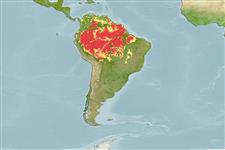Classification / Names
ชื่อสามัญ | ชื่อพ้อง | Catalog of Fishes (gen., sp.) | ITIS | CoL | WoRMS | Cloffa
กลุ่มปลาที่มีครีบคู่ แผ่แบนออกได้ลักษณะคล้ายพัด >
Perciformes (Perch-likes) >
Cichlidae (Cichlids) > Cichlasomatinae
Etymology: Aequidens: Latin, aequus, equal, equally + Latin, dens, dentis = teeth (Ref. 45335).
ภาวะแวดล้อม / สภาพภูมิอากาศ / พิสัย
นิเวศวิทยา
; น้ำจืด กลุ่มสัตว์หน้าดิน,กลุ่มสัตว์พื้นท้องน้ำ; pH range: 4.9 - 7.5; dH range: 1 - 13.5. Tropical; 24°C - 26°C (Ref. 1672), preferred ?
South America: widely distributed in the Amazon River basin in Peru, Colombia, Ecuador, Brazil and Bolivia. Also in the Tocantins and Parnaíba rivers, French Guiana, Suriname, Guyana, and in the Orinoco River basin of Venezuela and Colombia.
ขนาด / น้ำหนัก / Age
Maturity: Lm ? range ? - ? cm
Max length : 16.2 cm SL เพศผู้/กระเทย; (Ref. 36377)
One of the most colorful species of the genus, especially during its reproductive period. Frequently occurs in zones with little current and over a substrate covered with vegetal debris (Ref. 27188). Caught frequently but not abundantly in most varied biotopes- in small creeks and flooded zones with clear, shallow and slow flowing water. Feeds primarily on insects, secondarily on fishes and plants. Very territorial. During reproduction, males attain a deeper coloration. About 1,000 eggs are released during spawning. Spawning takes place on stone or wood. Parents take care of juveniles (Ref. 35237). Maximum length 25 cm TL (Ref. 1672).
Life cycle and mating behavior
วัยเจริญพันธุ์ | การสืบพันธุ์ | การวางไข่ | เซลสืบพันธ์ของเพศเมีย(ไข่) | ความดกของไข่ | ตัวอ่อน
Produces a minimum of 1000 eggs (Ref. 1672).
Kullander, S.O. and H. Nijssen, 1989. The cichlids of Surinam: Teleostei, Labroidei. E.J. Brill, Leiden, The Netherlands. 256 p. (Ref. 26372)
IUCN Red List Status (Ref. 115185)
CITES (Ref. 94142)
Not Evaluated
Threat to humans
Harmless
Human uses
การประมง: มีการค้าเพียงเล็กน้อย; สถานที่แสดงสัตว์และพืชน้ำ: การค้า
ข้อมูลเพิ่มเติม
ชื่อสามัญชื่อพ้องกลไกการเผาผลาญพลังงานผู้ล่าการศึกษาเกี่ยวกับผลกระทบของสารประกอบทางเคมีที่เป็นอันตรายต่อสิ่งมีชีวิต ประชากร และสิ่งแวดล้อมการสืบพันธุ์วัยเจริญพันธุ์การวางไข่ความดกของไข่เซลสืบพันธ์ของเพศเมีย(ไข่)Egg development
อ้างอิงการเพาะเลี้ยงสัตว์น้ำประวัติการเพาะเลี้ยงสัตว์น้ำสายพันธุ์พันธุศาสตร์ความถี่ของคู่ยีนอัตราพันธุกรรมโรคการแปรรูปMass conversion
เครื่องมือ
Special reports
Download XML
แหล่งที่มาจากอินเตอร์เน็ต
